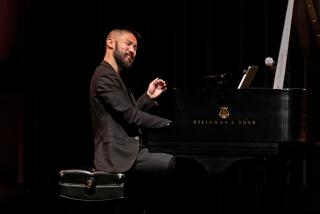MUSIC REVIEW : Romero Skills Plentiful; Fare Too Similar : Romanticism: Part of the problem for the Chula Vista native was the program’s lack of stylistic contrast.
- Share via
SAN DIEGO — Whenever pianist Gustavo Romero performs here, he draws an understandably partisan audience. Although the 26-year-old Chula Vista native has lived in New York since age 14, he has returned to perform for his loyal San Diego supporters with predictable regularity.
Sunday afternoon’s Community Concert Assn. audience at Copley Symphony Hall eagerly applauded the young pianist’s virtuosity, an athletic velocity that rarely sacrificed clarity and focus. Romero’s comfortable prowess notwithstanding, the musical rewards remained surprisingly modest.
Part of the problem was the program’s lack of stylistic contrast.
Romero chose monochromatically Romantic repertory--Schubert, Chopin and Rachmaninoff--except for three short Domenico Scarlatti sonatas that opened the program. And even those 18th-Century harpsichord pieces were interpreted in a Romantic style, punctuated with aggressive articulations and wide dynamic contrasts. This may be a legitimate approach when playing Scarlatti on the piano, but in this context it nudged Scarlatti’s crisp Baroque polyphony into the Romantic ethos.
Romero did dig deeply into Schubert’s Four Impromptus, Op. 90, exposing their poignant inner drama while maintaining the flow of their elegant figuration. The composer’s limpid melodies, notably the theme from the G-flat Major Impromptu, sang eloquently in Romero’s hands.
Coming on the heels the Schubert Op. 90, Chopin’s “Andante spianato et grand polo naise,” Op. 22, sounded like just another variation on the same mellifluous theme. Though Romero gave the extroverted polonaise its wonted panache, his playing hovered elegantly on the surface of the familiar Chopin opus.
The second half of the program was devoted to Rachmaninoff’s mighty and unjustly neglected Sonata No. 2 in B-flat Minor. Compared to Romero’s traversal of the Rachmaninoff Third Piano Concerto with the Liege Philharmonic in 1987 in the same hall, his strength and command of Rachmaninoff’s demanding idiom has grown considerably. But, if the sonata’s bravura technical requirements did not daunt him, its inner unity and melodic sweep eluded him.
More to Read
The biggest entertainment stories
Get our big stories about Hollywood, film, television, music, arts, culture and more right in your inbox as soon as they publish.
You may occasionally receive promotional content from the Los Angeles Times.










